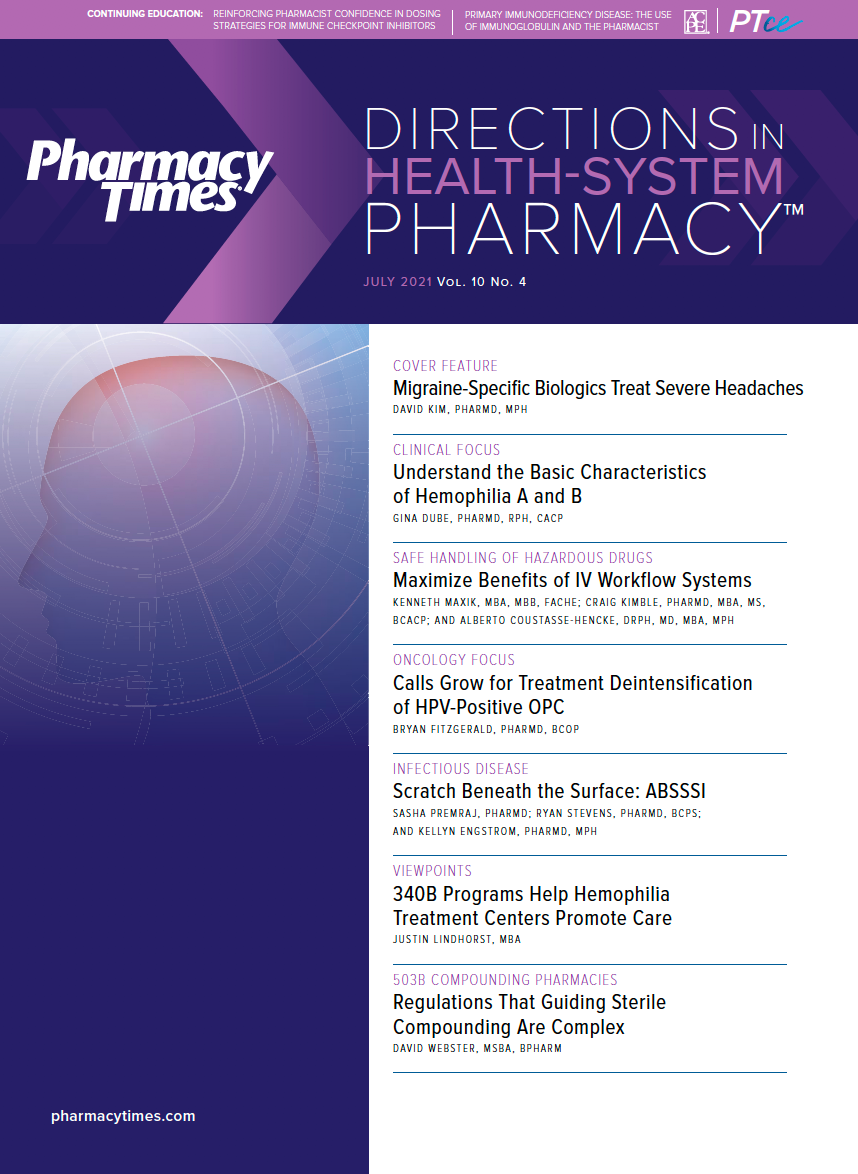Publication
Article
Pharmacy Practice in Focus: Health Systems
Understand the Basic Characteristics of Hemophilia A and B
Author(s):
A multidisciplinary team of health care professionals, including pharmacists, can work together to treat patients with the bleeding disorder.
Hemophilia is an inherited bleeding disorder in which the blood lacks clotting factors, which work with platelets to stop bleeding at the site of an injury. As a result, bleeding may last longer, and individuals with hemophilia are also more susceptible to internal bleeding. There are 2 major types of hemophilia. The first is classic hemophilia, also known as hemophilia A, which is triggered by an absence or reduction of clotting factor VIII. The second type of hemophilia is Christmas disease, also known as hemophilia B. This type of hemophilia is triggered by an absence or reduction of clotting factor IX.1 Either type can lead to spontaneous bleeding into joints, muscles, and organs.2 Hemophilia mostly affects males who inherit an affected maternal X chromosome, but there are rare circumstances when a female is affected with the blood disorder. In such cases, both X chromosomes are affected, or 1 is affected and the other is inactive.3
The number of males with hemophilia in the United States is estimated at between 30,000 and 33,000.2 The incidence of hemophilia A in the United States is 5617 per male births and is 19,283 per male births for hemophilia B.2 Hemophilia is more common in Latino and White individuals and less common in those who are Asian American or Black. The prevalence is highest in the Midwest and Northeast.2 Hemophilia is caused by mutations in either the factor IX or VIII genes on the X chromosome.4
DIAGNOSIS AND CLINICAL CLASSIFICATIONS
A factor assay is performed to demonstrate whether blood clotting occurs appropriately or how much factor IX or VIII is present.4 These tests help determine the severity and type of hemophilia. Individuals whose blood has 5% to 30% or 5 to 40 IU/dL of the normal level of clotting factors have mild hemophilia.3,4 For individuals with mild hemophilia, bleeding mostly results from invasive procedures, severe injury, or surgery.4 These individuals rarely present with joint bleeding (hemarthrosis) or severe bleeding associated with major trauma or surgery.3,4 Individuals with 1% to 5% or 1 to 5 IU/dL of the normal level of clotting factors are considered as having moderate hemophilia. They mostly experience bleeding with slight injury or prolonged bleeding with minor trauma or surgery.3,5 They may experience joint bleeding. Individuals with a clotting factor level less than 1% or less than 1 IU/dL have severe hemophilia.3,4 They experience spontaneous bleeding into joints or muscles 1 to 2 times per week, predominantly in the absence of identifiable hemostatic challenge.3,5 The risk of joint bleeding is significantly higher in those with severe hemophilia.
TREATMENT GUIDELINES
Individuals with hemophilia are regarded as having a complex medical history. Thus, the World Federation of Hemophilia (WFH) guidelines recommend coordinated delivery of comprehensive care by a multidisciplinary team of health care professionals with experience and expertise in hemophilia.3 It also recommends access to a coagulation laboratory capable of performing clotting factor assays and inhibitor testing; appropriate clotting factor concentrates (CFCs), either plasma derived or recombinant, as well as other hemostatic agents, such as antifibrinolytics (eg, ε-aminocaproic acid or tranexamic acid); casting and/or splinting for immobilization and mobility/support aids, as needed; emergency care; and safe blood components, such as cryoprecipitate and fresh frozen plasma that have been adequately screened, tested, and/or virus inactivated if CFCs are not available.3
Other forms of therapies that play a major role in hemophilia treatment include adjunctive and home therapy, dental care and management, pain management, and transition from pediatric to adult care.3 Adjunctive therapies are essential in the treatment of bleeding, predominantly where coagulation therapies and hemostatic agents are limited.3 In addition, first aid measures are key components of adjunctive therapy, especially the PRICE principles: protection, rest, ice, compression, and elevation.3
The WFH recommends CFCs as the treatment of choice for individuals with hemophilia because of the convenient high doses of clotting factor for the prevention and treatment of bleeding.3 Treatment option plans are also based on whether hemophilia is present with or without inhibitors. Inhibitors occur because of complications in patients with hemophilia A or B who develop factor IX or VIII alloantibodies called inhibitors that deactivate the function of infused CFCs. In such cases, bypassing agents such as activated prothrombin complex concentrate and recombinant activated factor VIIa are used for the prevention and treatment of bleeding complications.3 Desmopressin is another treatment of choice for patients with mild or moderate hemophilia A, because it avoids the expense and potential hazards of using CFCs, as well as the risk of factor VIII inhibitor development.3
More research is needed to critically evaluate the management of hemophilia A and B. As the science of hemophilia continues to evolve, more evidence-based guidelines will be needed in areas where the methodological rigor will be established to provide standardized recommendations.
ABOUT THE AUTHOR
Gina Dube, PharmD, RPh, CACP, is an advanced practice clinical pharmacist at Brigham & Women's Anticoagulation Management Service in Boston, Massachusetts.
REFERENCES
1. What is hemophilia? CDC. Updated July 17, 2020. Accessed May 1, 2021. https://www.cdc.gov/ncbddd/hemophilia/facts.html
2. Soucie JM, Miller CH, Dupervil B, Le B, Buckner TW. Occurrence rates of haemophilia among males in the United States based on surveillance conducted in specialized haemophilia treatment centres. Haemophilia. 2020;26(3):487-493. doi:10.1111/hae.13998
3. Srivastava A, Santagostino E, Dougall A, et al; WFH Guidelines for the Management of Hemophilia panelists and co-authors. WFH guidelines for the management of hemophilia, 3rd edition. Haemophilia. 2020:26(suppl 6):1-158. doi:10.1111/hae.14046
4. Hemophilia. Cleveland Clinic. Updated January 17, 2020. Accessed May 7, 2021. https://my.clevelandclinic.org/health/diseases/14083-hemophilia
5. Protocols for the treatment of hemophilia and von Willebrand disease. Hemophilia of Georgia. April 2008. Accessed May 7, 2021. http://www1.wfh.org/publication/files/pdf-1137.pdf







